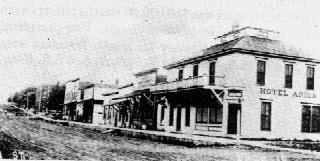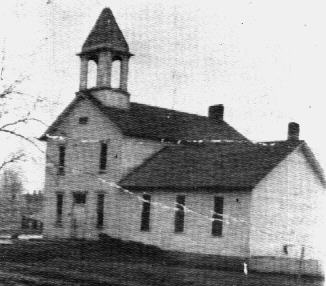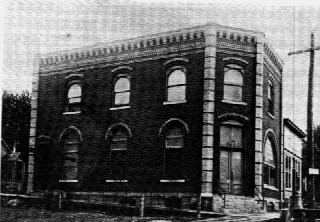Early Arion History
Main Street Arion
Arion and the Railroad
The greatest factor in the development of Arion was probably the railroad. The main line of the Northwestern Railroad was laid from Denison westward about 1866. Later the Chicago Milwaukee and St. Paul laid a new line from Manilla through Lydia (later named Arion) in 1886. A little later a side track was put in at Bellville (later named Belltown and Bell) and the railroad hoped to reach Paradise Station in Section 9 of Paradise Township (which later became Kenwood). By June of 1887, regular trains began to run on the Milwaukee line from Manilla to Sioux City. It took three and one-half hours to run the ninety miles.
There was no stop at Arion where the Milwaukee crossed the Northwestern. The question arose whether a depot was necessary at the crossing. The Milwaukee had no objections. The Northwestern was willing to put in a "Y" for freight traffic, but no depot. Citizens of Denison wanted a depot platform and depot to accommodate people traveling from towns on the Milwaukee line to get to Denison. Dow City and Belltown were against it, believing a depot would mean a town so close would hurt both the businesses in Dow City and Belltown. The plan of the General Assembly was to accommodate the traveling public rather than the interests of those living near the railroad crossing. By the middle of February 1888 the railroad crossing was being called Arion.
The sale of lots began in earnest in Arion in May 1888. All lots were sold, bringing from $25 to $70 apiece. Total receipts for sale of lots was $3,500.00. The town was incorporated in 1894. In 1899, the Illinois Central Railroad was laid through Arion, making it a junction point of three railroads.
The Arion Post Office
Miss Lydia Lanning had come to what is now Arion in 1886 to teach in the local school. She was married to Mr. "Chin" Butler in 1887. She was appointed postmaster after taking a Civil Service examination in the office of Lydia on July 2, 1888.
When the post office was established at Arion on July 2, 1888, it took the name of Lydia. Two and a half years later the name was changed to Arion, on December 19, 1890.
Former postmasters of Arion (Lydia) were: Lydia Butler, appointed July 1, 1888; Lewis M. Goon, May 17, 1890; Newton Richards, November 18, 1890; Changed to Arion on December 19, 1890; Newton Richards, December 19, 1890; Fred A. Pett, October 13, 1893; Mrs. Ellen N. Richards, August 2, 1897; Warren B. Evans, July 26, 1900; Marshall W. Maxey, January 19, 1907; Mary A. Evans (Name changed to Mary A. Nichols on July 20, 1911), January 28, 1910; Miss Gertrude E. Talcott, August 29, 1914; Mrs. Grace Kepford (acting postmaster), February 29, 1956; Ruth P. Davis, October 18, 1956; Mrs. Elsie V. Wingrove (acting postmaster), January 5, 1962; Mrs. Wilda B. Mullen, September 11, 1962; LaVonne B. Brink (officer in charge), November 19, 1976; LaVonne B. Brink, April 5, 1980; Alice Nollen (officer-in-charge), October 2, 1987; and Cheryl L. Ketelsen, January 30, 1988.
Town Government
The first mayor was Mr. S.H. Richardson who early engaged in the hotel business. He died during his term and S.H. Downs presided over the council, until the election of W.B. Evens in 1896. In 1898 Valdo Talcott was elected, and upon his resignation Mr. Bert Slocum was elected to fill the vacancy. The following were succeeding mayors: 1900, W.B. Evens; 1902, L.M. Goon; 1904-1906, J.L. Mauer; 1908, A.A. Conrad; 1910, N.F. Stilson. In 1910 J.A. Rule was clerk, and council members were C.W. Nelson, A.A. Conrad, Henry Petersen, A.J. Mauer and J.N. Lee.
Due to the three railroads, Arion's early history was marked by some lawlessness on account of the fact that it was a convenient stopping point for that class of undesirable citizens known as tramps. Mr. Cummings was appointed deputy sheriff and lived here until 1907, when he moved to Denison.
The city water system was installed in 1905 and provided the town with an ample supply of water and good fire protection. Arion had a good voluntary fire department.
Businesses
Due to the three railroads, hotels were in great demand to accommodate the travelers in the early days. In the picture at the top of the pages is the Greens' hotel which was built exclusively for hotel purposes. The next building was a restaurant and also rooms for rent.
A.A. Conrad's store was the next building, then the repair and shoe shop. The post office was the next building, Emil Schwartz's meat market was next, then the barbershop and pool hall. The Arion hotel known as the "square hotel" was the Illinois Central depot, and the grain elevator beyond the depot was destroyed by fire in the '20s and never rebuilt.
In 1921 there was a disastrous fire. An entire row of buildings extending from the post office to and including Greens' hotel was destroyed. These buildings were never replaced.
See inside one store on Main Street in Arion before the fire.
The Arion Milling and Cereal Company, a three-story building, was erected in 1904 along the north side of the Milwaukee Railroad in the west part of town. After the mill ceased operating, the power was used to furnish electricity for Arion until the Iowa Public Service came through. Arion being the second town in Crawford County furnished electricity by this company.
The Arion business houses included three hotels, general store, meat market and grocery, hardware, plumbing, and harness shops, a shoe and furnishing goods store, barbershop, restaurant and lunchroom, pool hall, saloon, lumberyard, livery stable, blacksmith and wagon shop, two elevators and grain business, bank, garage, hospital, doctor's office and drugstore, building contractor, mason and dray wagon, and telephone office; also, three railroad stockyards.
Arion received a temporary setback when the large store building of the Arion Mercantile Company, together with other business houses, was totally destroyed by fire on October 11, 1909. The town recovered from this and showed a commendable spirit of progress and activity. In the 1920s and 1930s Charles Henkin ran the general mercantile store.
The Star Restaurant was built in 1909 by John Thompson. In 1947, the restaurant was sold to the Congregational Church and remodeled to be used as a parsonage and library. Many bake sales and social gatherings were held there. In 1985 it was destroyed by fire.
Newspaper
In 1919 Arion had a newspaper, but it was short-lived. News articles about Arion and its residents published in the Denison Review from 1888 - 1896 can be found in the blue folder.
Arion News in the Denison Review, 1888 - 1896
Arion School System
The Arion school system was originally part of the Union Township school system. On August 1, 1910, Arion became an independent district. N.P. Stilson, George Argotsinger, Henry Petersen, Joseph Kepford, and George Reynolds were elected as directors; J.A. Rule, clerk; P.M. Doidge, treasurer.
The Old Arion School
The first school erected had only two rooms, and the teachers were Miss Mabel Howorth, principal; Mrs. C.C. Bunch, assistant; and Miss Lyle Goldsworth, primary. A few years later another room was added to the schoolhouse. The old Higley School was moved into Arion from its location about one and one-half miles south and east of Arion. The extra schoolroom now gave the students an opportunity to attend school through grade ten in Arion.
In 1913 the first class of four, namely Foster Kepford, Grace Butler, Lila Lee and Florence Johnson, graduated from the Arion School. H.P. Mauer was the principal, and Ferne Butler, assistant principal.
In 1939, a new two story brick building was built. There were four classrooms on the main floor, and four rooms in the basement that were used as furnace, kitchen, school board, and recreation rooms. The latter was used by the community for many occasions. In recent years the school was closed; students are presently bused to Dow City for grade school and to Dunlap for high school.
The Arion State Bank
The Arion State Bank was organized in August 1902 with Capital stock of $10,000.00. The officers were J.L. Mauer, president; W.B. Evens, Vice-president; and M.B. Nelson, Secretary-Treasurer, Directors were J.L. Mauer, W.B. Evens, M.B. Nelson, and E.R. King; C.M. Criswell, Cashier. This bank held and deserved the confidence of the community and did excellent banking business for many years.
In 1903, the bank built a two-story brick building which was occupied on the first floor by the offices of the bank and post office, which was presided over by Mrs. W.B. Evens, and on the second floor by the offices of the Arion exchange of the Crawford County Telephone Company, which operated from this point the telephones of Dow City and a large area in the southwestern part of the county.
The County Home
In 1905, the first County Home was totally destroyed by fire. On September 1, 1911, a new three-story brick building was built one-half mile east of Arion. Mr. and Mrs. John Blackman were the first custodians, then August Limbrechts, followed by the Henry Petersons. On September 1, 1933, Mr. and Mrs. Rudolph Bloes were appointed and held that position until February 1960, when Mr. Bloes passed away. Mrs. Bloes remained at the home until January 1, 1962, when she retired and moved to Denison. The home has had several administrators since that time.
The County Fair
The people of Arion and vicinity engaged as a whole, assisted by good men from all over the county, in founding and maintaining the Crawford County Fair at Arion, starting in 1907. An association was formed, grounds leased, and successful exhibitions given for years. The fairgrounds were located on ground between Arion and the Boyer River south of town.
The officers of the Crawford County Agricultural Society were W.E. Eggers, president; Charles Smith Sr., vice-president, Dow City; A.M. Criswell, secretary, Arion; and J.B. Glassburner, treasurer, Arion.
Everyone looked forward to September and the annual event--"The Arion Fair!" The ladies worked feverishly over their wood and cob burning cook stoves and ovens preparing their breads, pies, cookies, jellies, etc., to show at the fair. Sewing and other skills were also shown. Everyone hoped to be the winner of the coveted prizes. The men also excelled in their display of livestock and grains.
Both thoroughbred and harness races were very popular. Clarence Chamberlain was a sure race entry on his Harley-Davidson motorcycle, and he was usually the winner. Dances were given in the evenings. The schools in Crawford County were closed for one day so the students could attend the Arion Fair. This was the big event of the year. If it happened to rain--that was disaster! In later years the fair was moved to Denison.
The First Congregational Church of Arion
In the early history of Arion, there were three church organizations--Baptist, Methodist, and Christian, being supplied with ministers from Dow City. At a meeting of the various churches, it was decided that the town could not well support so many religious institutions and to lay aside differences of need; all the people joined in worshipping as one congregation.
Read the history of the church.
Sidelights
After World War I, a large three-tiered octagonal cement monument was erected in the Arion park with four trees, evenly spaced, planted around it. Each tree was to honor, and in memory of, four young men who died while in the service. They were, namely, Louis Miller, Carl Kepford, Ehrhardt Michaelsen, all three from the Arion area, and a Roosevelt son.
In the 1930s, weekly picture shows were a great attraction in the park during the summer months. The picture screen was set up very close and in line with the railroad. One evening while the audience was watching an exciting horse race, the train came from behind with its shrill whistle. It was a "nip and tuck" race between the "iron horse" and the team on the screen--most exciting; but no winner.
By 1941, the railroads had abandoned their separate depots and used only one together. The railroad tower, long a landmark along Highway 30 at Arion, was built shortly after the Milwaukee Railroad crossed the Northwestern Railroad. In January 1969 it was razed and taken over by the small building just north of the tower.
Source: The material on these pages is from the book 125 Years of Dow City - Arion History 1869 - 1994. The book belonged to Burdette Adams and was given to her grandaughter Cindi Simon who extracted the history for these pages. We thank both of them for sharing this history with us.
Submitted by Cindi Simon





